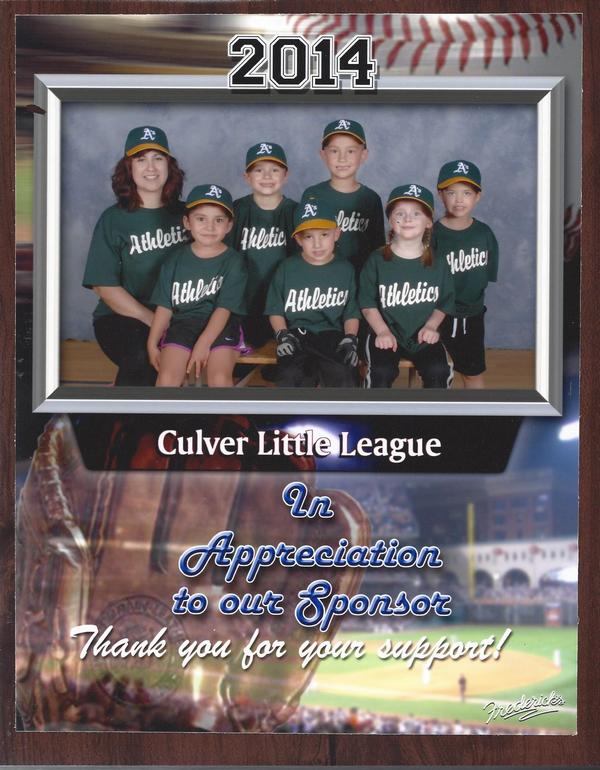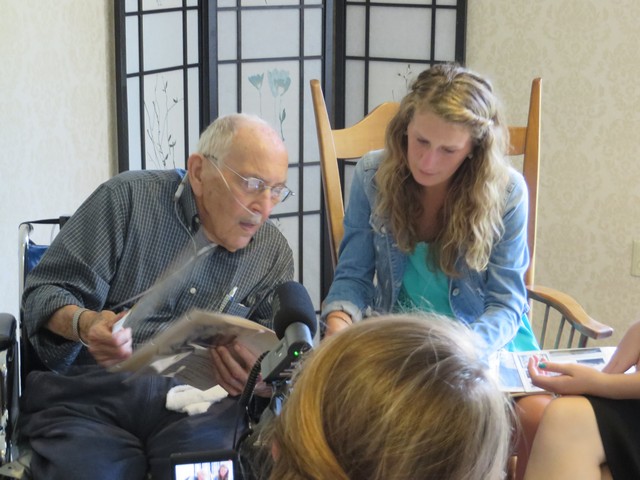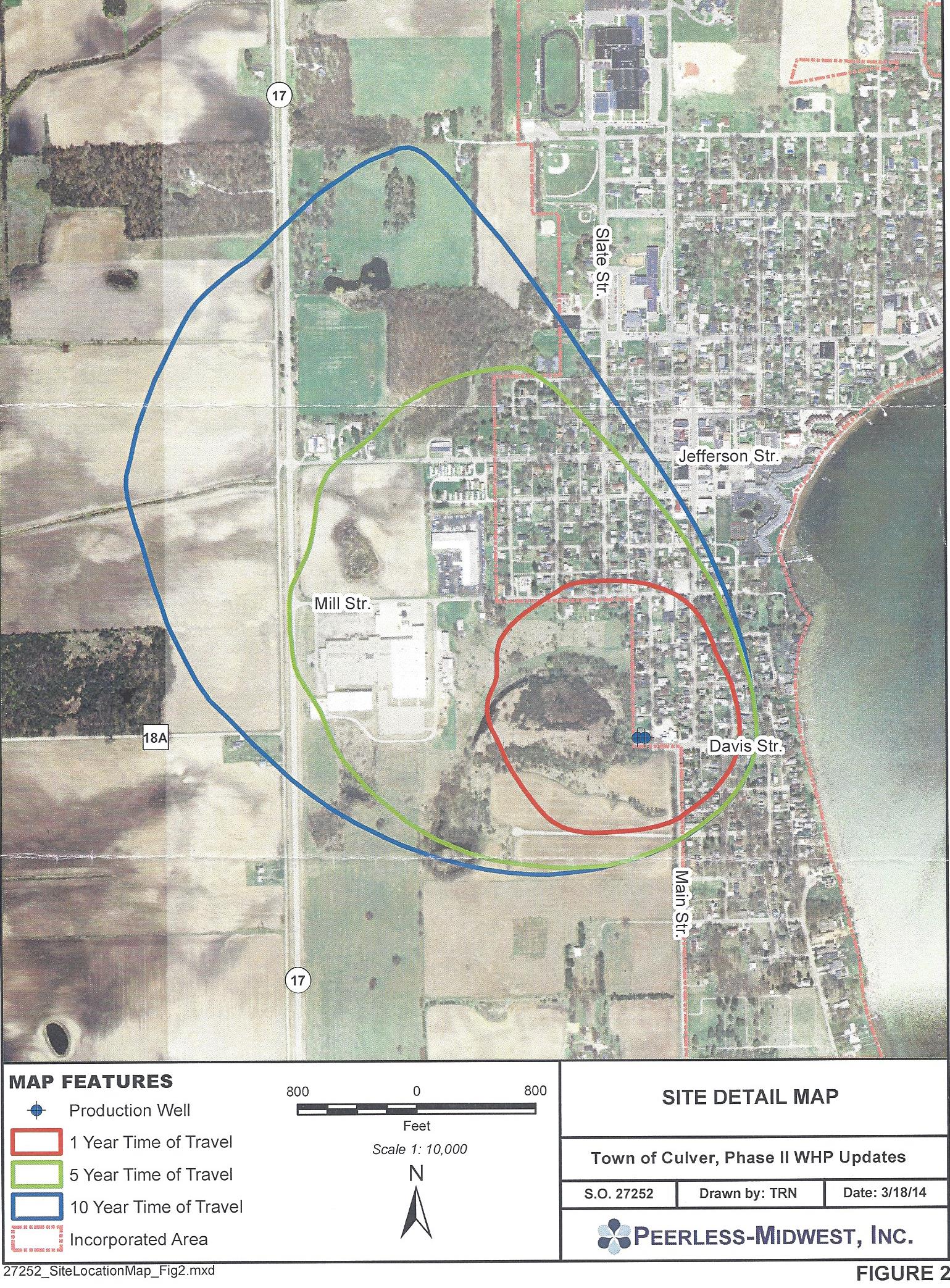Tag:Culver
Culver Wellhead Protection Map
I received the handy-dandy map to the right in the mail from the Town of Culver the other day along with a letter from Dave Schoeff, Culver Town Manager, talking about various procedures for protecting the well water for Culver’s municipal wells. All of it was a good reminder as ground water contamination isn’t something that people think about on a day to day basis. I doubt many people think about where the municipal tap water comes from beyond the faucet to which it is attached. I doubt many people really looked at the map either. Aside from the weird abbreviation for street “Str.” and the random dashed line area floating above the Lutheran Church property, two other things struck me. First being that the aerial photography for the base map is old. Construction began on Culver Garden Court in 2011 and it is not shown in the photograph. The second and more interesting thing pertinent to recent discussions is that the 10 year protection line extends very close to the current Culver Zoning Boundary.
Hopefully this will be added to the list of reasons why Culver should be allowed to extend their Territorial Authority per the Comprehensive Plan. Any decisions about development in these zones should be considered against the backdrop of wellhead protection along with all the other factors. If that is the 10 year line, then the 15 year line is farther out yet, not to mention some of the locations being considered for another well might have aquifer areas even farther out. Add this to your file Dave!
Little League 2014
 Easterday Construction has always sponsored a Little League team. We always ask for Easterday Green shirts and they try and accommodate us. The team is pictured to the right. I hit the organizers up about including names with the plaque. Some of those kids may work here someday and it would be fun to see the tie-in. Ha!
Easterday Construction has always sponsored a Little League team. We always ask for Easterday Green shirts and they try and accommodate us. The team is pictured to the right. I hit the organizers up about including names with the plaque. Some of those kids may work here someday and it would be fun to see the tie-in. Ha!
William K. Murphy Honored
 I’ve spoken about my grandfather, Bill Murphy, here before. Yesterday some students from Plymouth interviewed him as part of a project to record the memories of World War II veterans for the Marshall County Museum Historic Crossroads Center. Considering that my grandfather turned 100 years old this year, the pool of survivors has to be getting shallow.
I’ve spoken about my grandfather, Bill Murphy, here before. Yesterday some students from Plymouth interviewed him as part of a project to record the memories of World War II veterans for the Marshall County Museum Historic Crossroads Center. Considering that my grandfather turned 100 years old this year, the pool of survivors has to be getting shallow.
ABC 57 picked up the interview and had a short clip on the news last night. You can see it here if you’re interested. In the quote on the website he says that he was drafted, but actually Grandpa worked at Kingsbury Ordinance Plant and since that was a necessary service, he was not eligible for the draft. He quit that job and volunteered for the service, turning down the waiver.
Picture Source: Kelsey Flynn
Random Thought: A 2500′ Tape Measure

400′ Measuring Tape on Amazon.com
Just thinking about the new 2500′ WECS setback rule proposed by the Culver Plan Commission. How is the Building Commissioner going to measure that? The longest tape measure that I could find on Amazon.com was 400′. Looks like Culver will have to invest in a GPS, surveying equipment or a custom made tape. Russ may need some help stringing out 2500 linear feet of tape to make sure no one violates the rule! Unintended consequences… As we often find in my industry, what looks good on paper is sometimes tough to accomplish in the field.
Too Tired to Fight About it Further…
 Tired. Just tired. At the August 19th Plan Commission Meeting there was more discussion and a vote on revisions to the Zoning Ordinance regarding Wind Energy Conversion Systems (WECS). Type in “WECS” in the search box to the right to see past posts on this subject including the definition per the Culver Zoning Ordinance. It was obvious that the Plan Commission members were whipped on this issue, as was I. This is one that I really wish they had employed an outside consultant on. I feel that they got bogged down on details as they focused on specific WECS’s rather than making general rules that could be applied to all systems. So be it.
Tired. Just tired. At the August 19th Plan Commission Meeting there was more discussion and a vote on revisions to the Zoning Ordinance regarding Wind Energy Conversion Systems (WECS). Type in “WECS” in the search box to the right to see past posts on this subject including the definition per the Culver Zoning Ordinance. It was obvious that the Plan Commission members were whipped on this issue, as was I. This is one that I really wish they had employed an outside consultant on. I feel that they got bogged down on details as they focused on specific WECS’s rather than making general rules that could be applied to all systems. So be it.

Culver’s Zoning Boundary: The pink area shows the current extended territorial authority. The loop outside that shows the approximate limits if the Two Mile area was granted.
The main concession they made to the crowd was broadening the “protected” area, i.e., no vertical WECS’s within 2,500 feet of the L1, P1, R1, R2, C1 or C2 Zoning Districts. This extends the ban well outside the annexed area of town and effectively bans them from our current Extended Territorial Authority in several directions. I understand why they did this considering the vocal minority and their influence on the Town Council, but I’m afraid that this will kill our chances of achieving an expansion of our Extended Territorial Authority. I will beat this poor dead horse one more time here with another example:
Wherever this new restriction extends past our current Extended Territorial Authority it has no effect, i.e., if our Extended Territorial Authority is only 1,500 feet from one of the “protected” zoning districts, the additional 1,000 feet has no effect because it is in land governed by the County’s Zoning Ordinance, not Culver’s. My feeling is that anything like this… things that add restrictions that currently do not affect land within the County’s jurisdiction… will make it difficult if not impossible to extend our authority to include that area. Many outside the jurisdiction will fight any attempt to extend Culver’s jurisdiction just on principle. Why give them ammunition for the battle?
What many in the audience fail to understand about the above scenario is that there are other issues that will affect them. While we tried to mimic the County’s A-1 district when we created Culver’s, there are things there that are allowed by Special Use Permit. This means that they have to come before the BZA for approval. If those requests are under Culver’s Extended Territorial Authority, they come to Culver’s BZA. If they are under the County’s jurisdiction, they go to the County. The property owners within Culver’s jurisdiction may not even be notified, let alone have local representation.
I don’t know if I will speak to this further at the public hearing. I respect the Plan Commission and their attempts to accommodate all inspite of themselves. And we’re all tired… Just tired…
Picture source: LolSnaps.Org


